
A bean is the seed of any plant in the legume family (Fabaceae) used as a vegetable for human consumption or animal feed. The seeds are often preserved through drying, but fresh beans are also sold. Most beans are traditionally soaked and boiled, but they can be cooked in many different ways, including frying and baking, and are used in many traditional dishes throughout the world. The unripe seedpods of some varieties are also eaten whole as green beans or edamame, but fully ripened beans contain toxins like phytohemagglutinin and require cooking.

Sprouting is the natural process by which seeds or spores germinate and put out shoots, and already established plants produce new leaves or buds, or other structures experience further growth.

Legumes are plants in the family Fabaceae, or the fruit or seeds of such plants. When used as a dry grain for human consumption, the seeds are also called pulses. Legumes are grown agriculturally, primarily for human consumption, but also as livestock forage and silage, and as soil-enhancing green manure. Well-known legumes include beans, chickpeas, peanuts, lentils, lupins, mesquite, carob, tamarind, alfalfa, and clover. Legumes produce a botanically unique type of fruit – a simple dry fruit that develops from a simple carpel and usually dehisces on two sides.
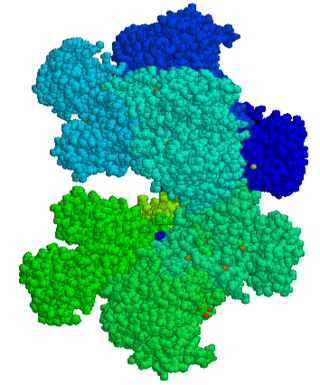
Glucose-6-phosphate dehydrogenase deficiency (G6PDD), also known as favism, is the most common enzyme deficiency anemia worldwide. It is an inborn error of metabolism that predisposes to red blood cell breakdown. Most of the time, those who are affected have no symptoms. Following a specific trigger, symptoms such as yellowish skin, dark urine, shortness of breath, and feeling tired may develop. Complications can include anemia and newborn jaundice. Some people never have symptoms.
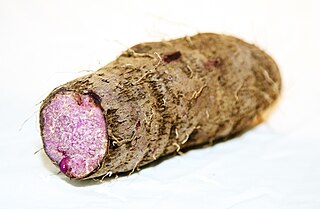
Dioscorea alata – also called ube, ubi, purple yam, or greater yam, among many other names – is a species of yam. The tubers are usually a vivid violet-purple to bright lavender in color, but some range in color from cream to plain white. It is sometimes confused with taro and the Okinawa sweet potato beniimo (紅芋), however D. alata is also grown in Okinawa. With its origins in the Asian and Oceanian tropics, D. alata has been known to humans since ancient times.

The cowpea is an annual herbaceous legume from the genus Vigna. Its tolerance for sandy soil and low rainfall have made it an important crop in the semiarid regions across Africa and Asia. It requires very few inputs, as the plant's root nodules are able to fix atmospheric nitrogen, making it a valuable crop for resource-poor farmers and well-suited to intercropping with other crops. The whole plant is used as forage for animals, with its use as cattle feed likely responsible for its name.

A lima bean, also commonly known as butter bean, sieva bean, double bean or Madagascar bean, is a legume grown for its edible seeds or beans.

Vigna subterranea is a member of the family Fabaceae. Its name is derived from the Bambara ethnic group. The plant originated in West Africa. As a food and source of income, the Bambara groundnut is considered to be the third most important leguminous crop in those African countries where it is grown, after peanut and cowpea. The crop is mainly cultivated, sold and processed by women, and is, thus, particularly valuable for female subsistence farmers.
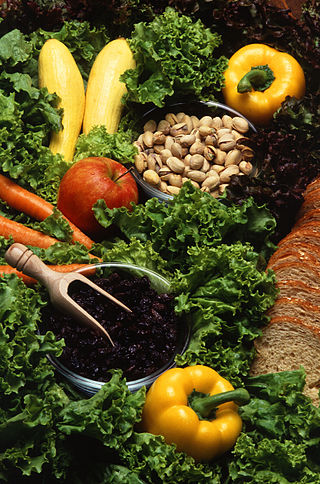
Vegetarian nutrition is the set of health-related challenges and advantages of vegetarian diets.

Lablab purpureus is a species of bean in the family Fabaceae. It is native to sub-Saharan Africa and India and it is cultivated throughout the tropics for food. English language common names include hyacinth bean, lablab-beanbonavist bean/pea, dolichos bean, seim or sem bean, lablab bean, Egyptian kidney bean, Indian bean, bataw and Australian pea. Lablab is a monotypic genus.
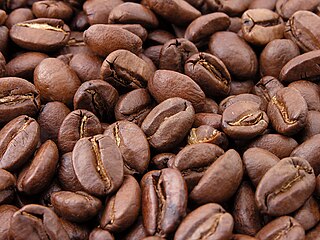
A coffee bean is a seed from the Coffea plant and the source for coffee. It is the pit inside the red or purple fruit. This fruit is often referred to as a coffee cherry, and like the cherry, it is a fruit with a pit. Even though the coffee beans are not technically beans, they are referred to as such because of their resemblance to true beans. The fruits most commonly contain two stones with their flat sides together. A small percentage of cherries contain a single seed, called a "peaberry". Peaberries make up only around 10% to 15% of all coffee beans. It is a fairly common belief that they have more flavour than normal coffee beans. Like Brazil nuts and white rice, coffee beans consist mostly of endosperm.

Egusi, also spelled egushi, are the protein-rich seeds of certain cucurbitaceous plants, which, after being dried and ground, are used as a major ingredient in West African cuisine. Egusi is a Yoruba word, and the popular method of cooking it is deeply rooted in Yoruba culinary traditions.

Ferulic acid is a hydroxycinnamic acid derivative and a phenolic compound. It is an organic compound with the formula (CH3O)HOC6H3CH=CHCO2H. The name is derived from the genus Ferula, referring to the giant fennel (Ferula communis). Classified as a phenolic phytochemical, ferulic acid is an amber colored solid. Esters of ferulic acid are found in plant cell walls, covalently bonded to hemicellulose such as arabinoxylans. Salts and esters derived from ferulic acid are called ferulates.

Yam is the common name for some plant species in the genus Dioscorea that form edible tubers.

Tylosema esculentum, with common names gemsbok bean and marama bean or morama bean, is a long-lived perennial legume native to arid areas of southern Africa. Stems grow at least 3 metres (9.8 ft), in a prostrate or trailing form, with forked tendrils that facilitate climbing. A raceme up to 25 millimetres (1 in) long, containing many yellow-orange flowers, ultimately produces an ovate to circular pod, with large brownish-black seeds.

Nigerian cuisine consists of dishes or food items from the hundreds of Native African ethnic groups that comprises Nigeria. Like other West African cuisines, it uses spices and herbs with palm oil or groundnut oil to create deeply flavored sauces and soups.
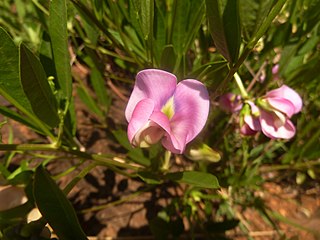
Sphenostylis is a genus of flowering plants in the legume family, Fabaceae. It includes seven species of prostrate, climbing or erect herbs or subshrubs. They are native to sub-Saharan Africa, where they grow in seasonally-dry tropical and subtropical open forest, woodland, bushland and thicket, wooded grassland, and grassland, mainly in the Zambezian and Sudanian regions. It belongs to the subfamily Faboideae. Sphenostylis contains several species useful as food sources including Sphenostylis stenocarpa. Sphenostylis stenocarpa is characterized by its fruit (legume) and stipulated leaves.
Divicine (2,6-diamino-4,5-dihydroxypyrimidine) is an oxidant and a base with alkaloidal properties found in fava beans and Lathyrus sativus. It is an aglycone of vicine. A common derivative is the diacetate form (2,6-diamino-1,6-dihydro-4,5-pyrimidinedione).

A staple food, food staple, or simply staple, is a food that is eaten often and in such quantities that it constitutes a dominant portion of a standard diet for an individual or a population group, supplying a large fraction of energy needs and generally forming a significant proportion of the intake of other nutrients as well. For humans, a staple food of a specific society may be eaten as often as every day or every meal, and most people live on a diet based on just a small variety of food staples. Specific staples vary from place to place, but typically are inexpensive or readily available foods that supply one or more of the macronutrients and micronutrients needed for survival and health: carbohydrates, proteins, fats, minerals, and vitamins. Typical examples include grains, seeds, nuts and root vegetables. Among them, cereals, legumes and tubers account for about 90% of the world's food calorie intake.
Scutellonema bradys, also known as yam nematode, is a migratory endoparasitic nematode causing major damage to yam crop in many African tropical regions, as well in parts of South and Central America and Asia. They can cause reduction of 20-30% in tuber weight at harvest.

















